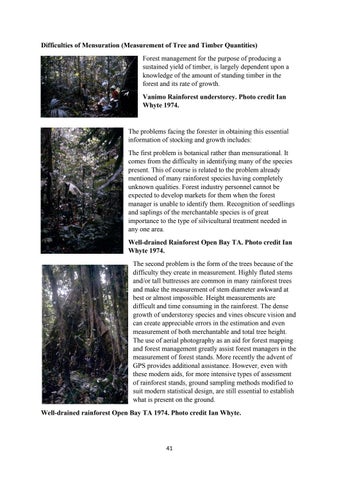Difficulties of Mensuration (Measurement of Tree and Timber Quantities) Forest management for the purpose of producing a sustained yield of timber, is largely dependent upon a knowledge of the amount of standing timber in the forest and its rate of growth. Vanimo Rainforest understorey. Photo credit Ian Whyte 1974.
The problems facing the forester in obtaining this essential information of stocking and growth includes: The first problem is botanical rather than mensurational. It comes from the difficulty in identifying many of the species present. This of course is related to the problem already mentioned of many rainforest species having completely unknown qualities. Forest industry personnel cannot be expected to develop markets for them when the forest manager is unable to identify them. Recognition of seedlings and saplings of the merchantable species is of great importance to the type of silvicultural treatment needed in any one area. Well-drained Rainforest Open Bay TA. Photo credit Ian Whyte 1974. The second problem is the form of the trees because of the difficulty they create in measurement. Highly fluted stems and/or tall buttresses are common in many rainforest trees and make the measurement of stem diameter awkward at best or almost impossible. Height measurements are difficult and time consuming in the rainforest. The dense growth of understorey species and vines obscure vision and can create appreciable errors in the estimation and even measurement of both merchantable and total tree height. The use of aerial photography as an aid for forest mapping and forest management greatly assist forest managers in the measurement of forest stands. More recently the advent of GPS provides additional assistance. However, even with these modern aids, for more intensive types of assessment of rainforest stands, ground sampling methods modified to suit modern statistical design, are still essential to establish what is present on the ground. Well-drained rainforest Open Bay TA 1974. Photo credit Ian Whyte.
41









